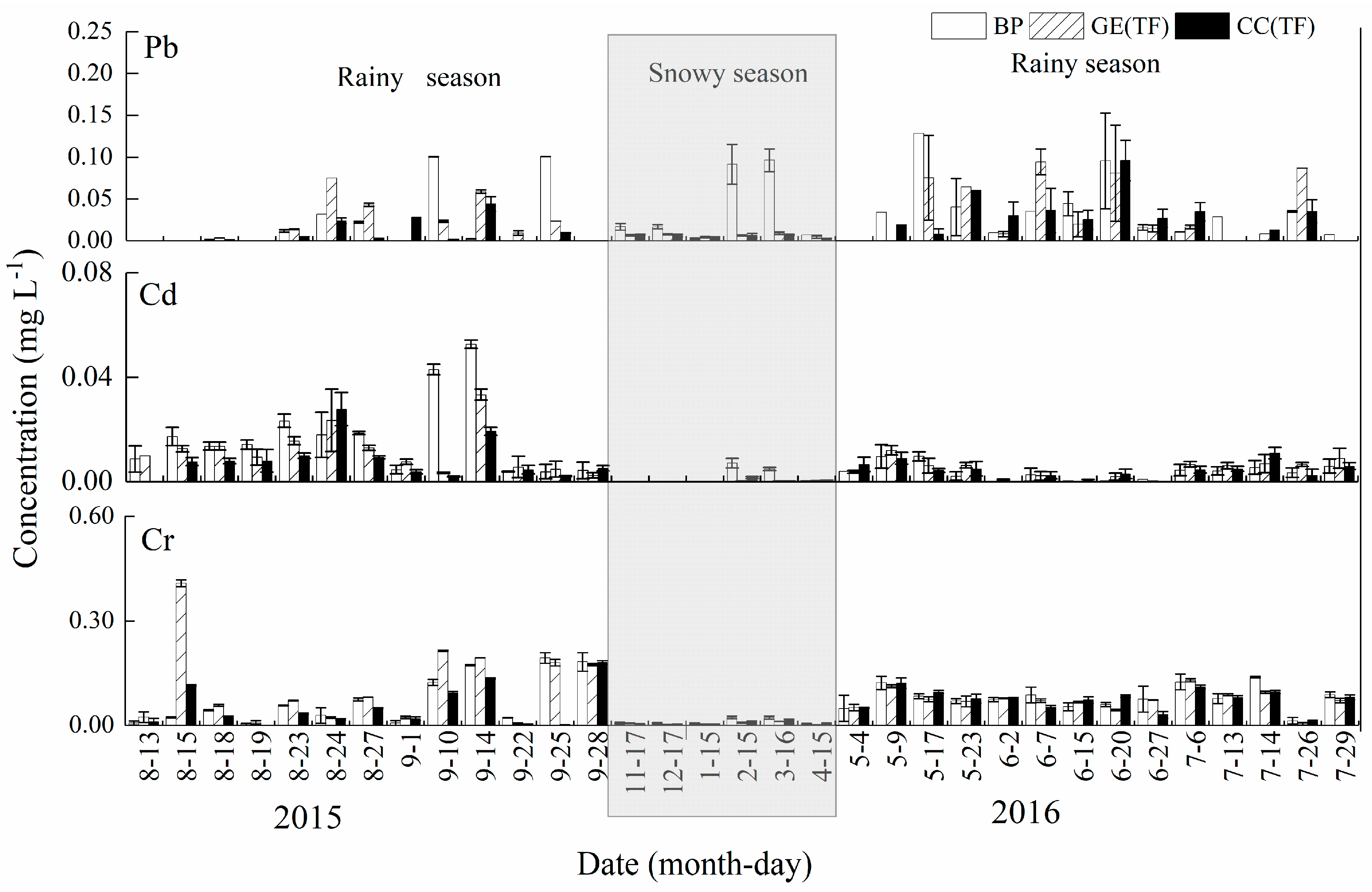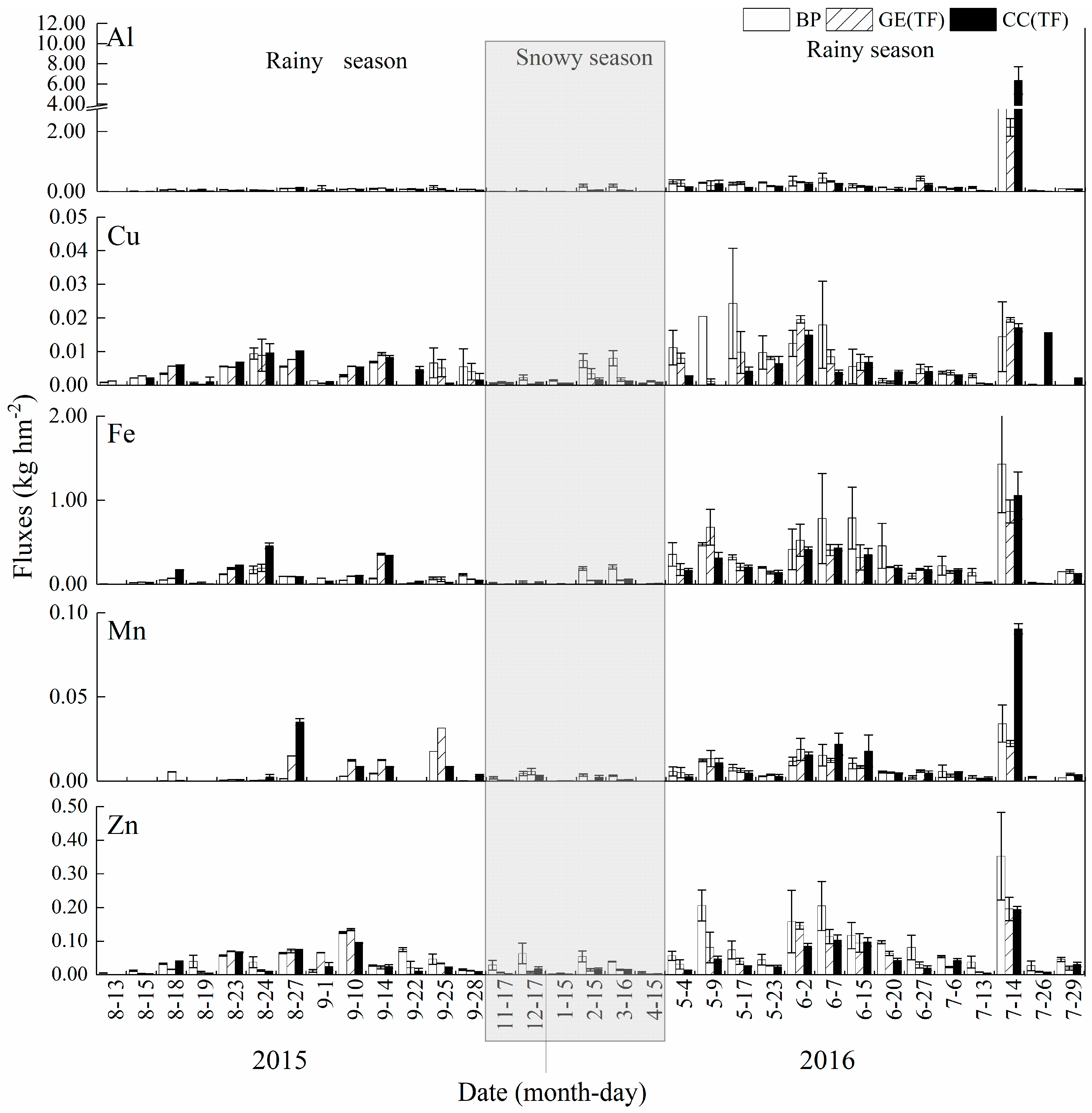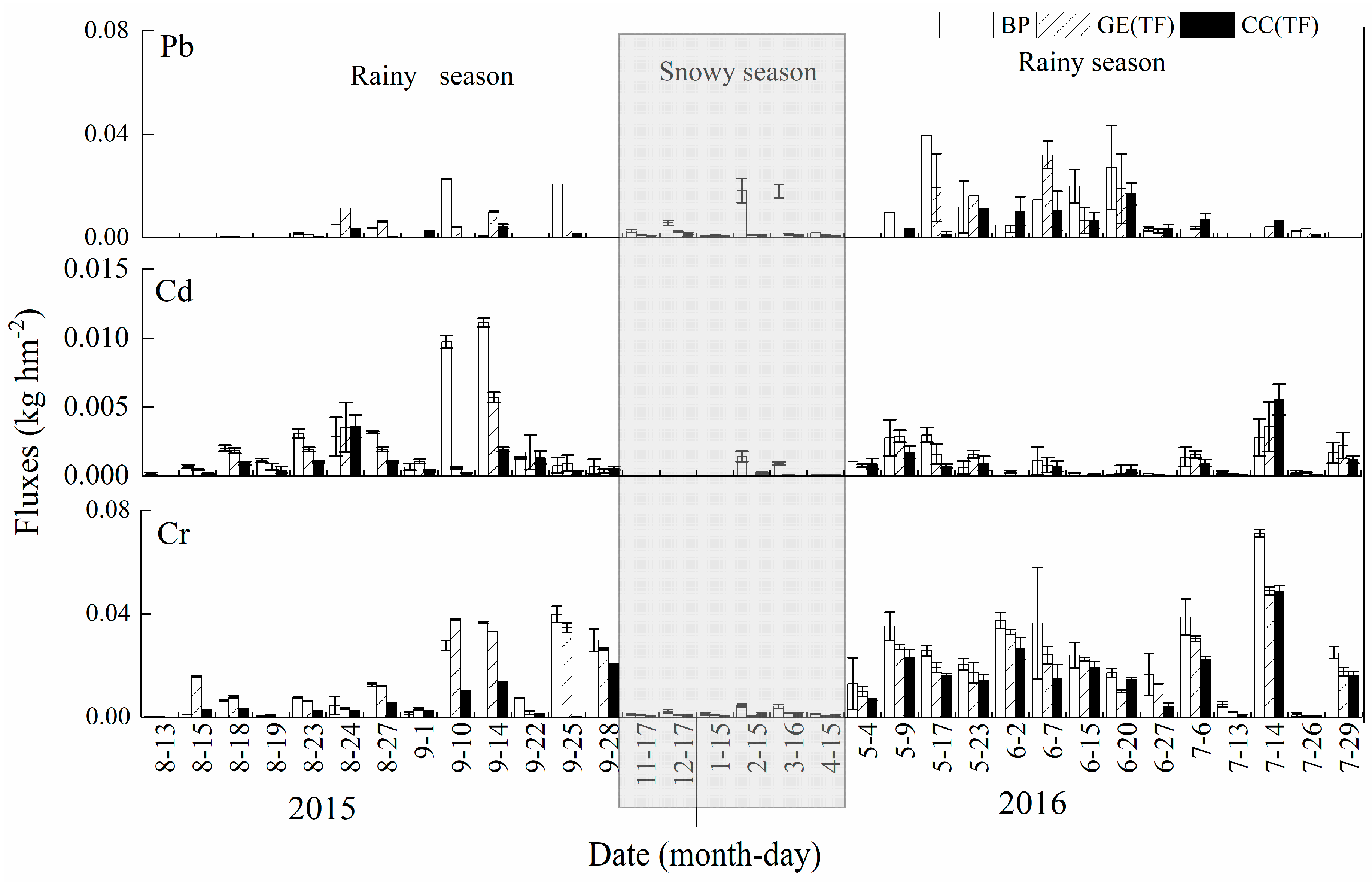Forest Canopy Can Efficiently Filter Trace Metals in Deposited Precipitation in a Subalpine Spruce Plantation
Abstract
:1. Introduction
2. Materials and Methods
2.1. Site Description
2.2. Experimental Design
2.3. Precipitation Observations and Water Sampling
2.4. Chemical Analysis
2.5. Calculations
2.6. Statistical Analysis
3. Results
3.1. Annual Variations of Trace Metal Concentrations in Precipitation and Throughfall
3.2. Annual Variations of Trace Metal Fluxes in Precipitation and Throughfall
3.3. Variations of Net Throughfall Fluxes of Trace Metals Under the Closed Canopy and Gap-Edge Canopy
4. Discussion
5. Conclusions
Author Contributions
Funding
Acknowledgments
Conflicts of Interest
References
- Hou, H.; Takamatsu, T.; Koshikawa, M.K.; Hosomi, M. Trace metals in bulk precipitation and throughfall in a suburban area of Japan. Atmos. Environ. 2005, 39, 3583–3595. [Google Scholar] [CrossRef]
- Rauch, J.N.; Pacyna, J.M. Earth’s global Ag, Al, Cr, Cu, Fe, Ni, Pb, and Zn cycles. Glob. Biogeochem. Cycles 2009, 23, GB2001. [Google Scholar] [CrossRef]
- Siudek, P.; Frankowski, M. Atmospheric deposition of trace elements at urban and forest sites in central Poland—Insight into seasonal variability and sources. Atmos. Res. 2017, 198, 123–131. [Google Scholar] [CrossRef]
- Mayer, R.; Ulrich, B. Input of atmospheric sulfur by dry and wet deposition to two central European forest ecosystems. Atmos. Environ. 1978, 12, 375–377. [Google Scholar] [CrossRef]
- Wong, C.S.C.; Li, X.D.; Zhang, G.; Qiand, S.H.; Peng, Z. Atmospheric deposition of heavy metals in the Pear Delta, China. Atmos. Environ. 2003, 3, 767–776. [Google Scholar] [CrossRef]
- Nagajyoti, P.C.; Lee, K.D.; Sreekanth, T.V.M. Heavy metals, occurrence and toxicity for plants: A review. Environ. Chem. Lett. 2010, 8, 199–216. [Google Scholar] [CrossRef]
- Lee, C.S.L. Heavy metal concentrations and Pb isotopic composition in urban and suburban aerosols of Hong Kong and Guangzhou, South China—Evidence of the long-range transport of air contaminants. Acta Geochim. 2006, 25, 123–124. [Google Scholar] [CrossRef]
- Draaijers, G.P.J.; Erisman, J.W.; VanLeeuwen, N.F.M.; Romer, F.G.; TEWinkel, B.H.; Veltkamp, A.C.; Vermeulen, A.T.; Wyers, G.P. The impact of canopy exchange on differences observed between atmospheric deposition and throughfall fluxes. Atmos. Environ. 1997, 31, 387–397. [Google Scholar] [CrossRef]
- Avila, A.; Rodrigo, A. Trace metal fluxes in bulk deposition, throughfall and stemflow at two evergreen oak stands in NE Spain subject to different exposure to the industrial environment. Atmos. Environ. 2004, 38, 171–180. [Google Scholar] [CrossRef]
- Zhang, S.; Liang, C. Effect of a native forest canopy on rainfall chemistry in China’s Qinling Mountains. Environ. Earth Sci. 2012, 67, 1503–1513. [Google Scholar] [CrossRef]
- Stiller, M.; Sigg, L. Heavy metals in the Dead Sea and their coprecipitation with halite. Hydrobiologia 1990, 197, 23–33. [Google Scholar] [CrossRef]
- Staelens, J.; Houle, D.; An, D.S.; Neirynck, J.; Verheyen, K. Calculating Dry Deposition and Canopy Exchange with the Canopy Budget Model: Review of Assumptions and Application to Two Deciduous Forests. Water Air Soil Pollut. 2008, 191, 149–169. [Google Scholar] [CrossRef]
- Sun, X.Y.; Wang, G.X. The Hydro-chemical Characteristics Study of Forest Ecosystem Precipitation Distribution in Gongga Mountain. Res. Soil Water Conserv. 2009, 16, 120–124. [Google Scholar]
- Guo, J.; Kang, S.; Huang, J.; Zhang, Q.; Tripathee, L.; Sillanpää, M. Seasonal variations of trace elements in precipitation at the largest city in Tibet, Lhasa. Atmos. Res. 2015, 153, 87–97. [Google Scholar] [CrossRef]
- Wuyts, K.; Schrijver, A.D.; Verheyen, K.; Schaub, M. The importance of forest type when incorporating forest edge deposition in the evaluation of critical load exceedance. iFor. Biogeosci. For. 2009, 2, 385–392. [Google Scholar] [CrossRef]
- Yang, W.Q.; Wang, K.Y.; Kellomki, S.; Gong, H.D. Litter dynamics of Three subalpine forests in Western Sichuan. Pedosphere 2005, 15, 653. [Google Scholar]
- Hultberg, H.; Grennfelt, P. Sulphur and seasalt deposition as reflected by throughfall and runoff chemistry in forested catchments. Environ. Pollut. 1992, 75, 215–222. [Google Scholar] [CrossRef]
- Derome, J.; Nieminen, T. Metal and macronutrient fluxes in heavy-metal polluted Scots pine ecosystems in SW Finland. Environ. Pollut. 1998, 103, 219–228. [Google Scholar] [CrossRef]
- Yang, W.Q.; Wang, K.Y.; Kellomki, S.; Jian, Z. Annual and Monthly Variations in Litter Macronutrients of Three Subalpine Forests in Western China. Pedosphere 2006, 16, 788–798. [Google Scholar] [CrossRef] [Green Version]
- Wu, Q.G.; Wu, F.Z.; Yang, W.Q.; Tan, B.; Yang, Y.L.; Ni, X.Y.; He, J. Characteristics of Gaps and Disturbance Regimes of the Alpine Fir Forest in Western Sichuan. Chin. J. Appl. Environ. Biol. 2013, 19, 922. [Google Scholar] [CrossRef]
- Lu, J.; Zhang, S.; Fang, J.; Yan, H.; Li, J. Nutrient Fluxes in Rainfall, Throughfall, and Stemflow in Pinus densata Natural Forest of Tibetan Plateau. Clean Soil Air Water 2017, 45, 1600008. [Google Scholar] [CrossRef]
- Lovett, G.M.; Lindberg, S.E. Dry Deposition and Canopy Exchange in a Mixed Oak Forest as Determined by Analysis of Throughfall. J. Appl. Ecol. 1984, 21, 1013–1027. [Google Scholar] [CrossRef]
- Özsoy, T.; Örnektekin, S. Trace elements in urban and suburban rainfall, Mersin, Northeastern Mediterranean. Atmos. Res. 2009, 94, 203–219. [Google Scholar] [CrossRef]
- Schmidt, R.A.; Gluns, D.R. Snowfall Interception on Branches of Three Conifer Species. Can. J. For. Res. 1991, 21, 1262–1269. [Google Scholar] [CrossRef]
- Bao, W.; Bao, W.; He, B. Redistribution effects of tree canopy of the artificial Pinus tabulaeformis forest on precipitation in the upper stream of Minjiang River. J. Beijing For. Univ. 2004, 26, 10–16. [Google Scholar]
- Xiao, Q.Y.; Yin, C.Y.; Pu, X.Z.; Qiao, M.F.; Liu, Q. Ecophysiological characteristics of leaves and fine roots in dominant tree species in a subalpine coniferous forest of western Sichuan during seasonal frozen soil period. Chin. J. Plant Ecol. 2014, 38, 343–345. [Google Scholar]
- Sonja, G.; Christopher, N.; Alexv, K.; Sergiocgouveia, N.; Helmut, E. Seasonal and within-event dynamics of rainfall and throughfall chemistry in an open tropical rainforest in Rondonia, Brazil. Biogeochemistry 2007, 86, 155–174. [Google Scholar]
- Kimmins, J.P. Some Statistical Aspects of Sampling Throughfall Precipitation in Nutrient Cycling Studies in British Columbian Coastal Forests. Ecology 1973, 54, 1008–1019. [Google Scholar] [CrossRef]
- Zimmermann, A.; Wilcke, W.; Elsenbeer, H. Spatial and temporal patterns of throughfall quantity and quality in a tropical montane forest in Ecuador. J. Hydrol. 2007, 343, 80–96. [Google Scholar] [CrossRef]
- Draaijers, G.P.; Van Ek, R.; Bleuten, W. Atmospheric deposition in complex forest landscapes. Bound.-Layer Meteorol. 1994, 69, 343–366. [Google Scholar] [CrossRef]
- Michopoulos, P.; Bourletsikas, A.; Kaoukis, K.; Daskalakou, E.; Karetsos, G.; Kostakis, M.; Thomaidis, N.S.; Pasias, I.N.; Kaberi, H.; Iliakis, S. The distribution and variability of heavy metals in a mountainous fir forest ecosystem in two hydrological years. Glob. Nest J. 2018, 20, 188–197. [Google Scholar]
- Schliemann, S.A.; Bockheim, J.G. Influence of gap size on carbon and nitrogen biogeochemical cycling in Northern hardwood forests of Upper Peninsula. Plant Soil 2014, 377, 323–335. [Google Scholar] [CrossRef]
- Cornu, S.; Ambrosi, J.P.; Lucas, Y.; Desjardins, T. Origin and behaviour of dissolved chlorine and sodium in Brazilian Rainforest. Water Res. 1998, 32, 1151–1161. [Google Scholar] [CrossRef]
- Silva, I.C.; Rodríguez, H.G. Interception loss, throughfall and stemflow chemistry in pine and oak forests in northeastern Mexico. Tree Physiol. 2001, 21, 1009. [Google Scholar] [CrossRef]
- Säumel, I.; Kotsyuk, I.; Hölscher, M.; Lenkereit, C.; Weber, F.; Kowarik, I. How healthy is urban horticulture in high traffic areas? Trace metal concentrations in vegetable crops from plantings within inner city neighbourhoods in Berlin, Germany. Environ. Pollut. 2012, 165, 124. [Google Scholar] [CrossRef]
- Arvik, J.H.; Zimdahl, R.L. Barriers to the Foliar Uptake of Lead1. J. Environ. Qual. 1974, 3, 369. [Google Scholar] [CrossRef]
- Petty, W.H.; Lindberg, S.E. An intensive 1-month investigation of trace metal deposition and throughfall at a mountain spruce forest. Water Air Soil Pollut. 1990, 53, 213–226. [Google Scholar] [CrossRef]
- Stachurski, A.; Zimka, J.R. Atmospheric input of elements to forest ecosystems: A method of estimation using artificial foliage placed above rain collectors. Environ. Pollut. 2000, 10, 345–356. [Google Scholar] [CrossRef]
- Szarek-ŁUkaszewska, G. Input of chemical elements to the forest ecosystem on the (Carpathian Foothills, S Poland)—An overview. Pol. J. Ecol. 1999, 47, 191–213. [Google Scholar]
- Chinot, O.; Romain, S.; Martin, P.M. Effects of root and foliar treatments with lead, cadmium, and copper on the uptake distribution and growth of radish plants. Environ. Int. 1993, 19, 393–404. [Google Scholar]
- Schreck, E.; Laplanche, C.; Guédard, M.L.; Bessoule, J.J.; Austruy, A.; Xiong, T.; Foucault, Y.; Dumat, C. Influence of fine process particles enriched with metals and metalloids on Lactuca sativa L. leaf fatty acid composition following air and/or soil-plant field exposure. Environ. Pollut. 2013, 179, 242–249. [Google Scholar] [CrossRef]
- Tudoreanu, L.; Phillips, C.J.C. Modeling Cadmium Uptake and Accumulation in Plants. Adv. Agron. 2004, 84, 121–157. [Google Scholar]
- Levi, E.; Dalschaert, X.; Wilmer, J.B.M. Retention and absorption of foliar applied Cr. Plant Soil 1973, 38, 683–686. [Google Scholar] [CrossRef]
- Sun, T.; Ma, M.; Wang, D.Y. Interceptive characteristics of lead and cadmium in a representative forest ecosystem in mid-subtropical area in China. Acta Ecol. Sin. 2016, 36, 218–225. [Google Scholar]
- Heinrichs, H.; Mayer, R. The Role of Forest Vegetation in the Biogeochemical Cycle of Heavy Metals 1. J. Environ. Qual. 1980, 9, 226–231. [Google Scholar] [CrossRef]
- Parker, G.G. Throughfall and Stemflow in the Forest Nutrient Cycle. Adv. Ecol. Res. 1983, 13, 57–133. [Google Scholar]
- Leininger, T.D.; Winner, W.E. Throughfall chemistry beneath Quercusrubra: Atmospheric, foliar, and soil chemistry considerations. Can. J. For. Res. 1988, 18, 478–482. [Google Scholar] [CrossRef]
- Ahmadshah, A.; Rieley, J.O. Influence of tree canopies on the quantity of water and amount of chemical elements reaching the peat surface of a basin mire in the midlands of England. J. Ecol. 1989, 77, 357–370. [Google Scholar] [CrossRef]
- Skřivan, P.; Rusek, J.; Fottova, D.; Burian, M.; Minařík, L. Factors affecting the content of heavy metals in bulk atmospheric precipitation, throughfall and stemflow in central Bohemia, Czech Republic. Water Air Soil Pollut. 1995, 85, 841–846. [Google Scholar] [CrossRef]
- Gandois, L.; Tipping, E.; Dumat, C.; Probst, A. Canopy influence on trace metal atmospheric input on forest ecosystems: Speciation on throughfall. Atmos. Environ. 2010, 44, 824–833. [Google Scholar] [CrossRef]




| Item | Al | Zn | Fe | Mn | Cu | Pb | Cd | Cr | |
|---|---|---|---|---|---|---|---|---|---|
| Concentration | Canopy | 0.22 | 0.22 | 1.64 | 1.25 | 0.13 | 0.88 | 0.72 | 1.43 |
| Season | 7.70 ** | 31.83 ** | 44.60 ** | 12.24 ** | 6.89 ** | 11.18 | 37.28 ** | 39.94 ** | |
| Fluxes | Canopy | 0.78 | 0.38 | 0.10 | 0.24 | 0.49 | 1.316 | 0.83 | 2.28 |
| Season | 27.96 ** | 21.93 ** | 52.23 ** | 8.89 ** | 23.58 ** | 9.32 ** | 24.77 ** | 39.59 ** | |
| NTF | Canopy | 0.60 | 1.02 | 0.005 | 5.06 * | 0.57 | 5.57 * | 1.32 | 10.59 ** |
| Season | 0.54 | 0.32 | 0.004 | 0.48 | 0.24 | 0.57 | 0.26 | 4.74 * |
| Canopy | Season | Throughfall (mm) | Item | Al | Zn | Fe | Mn | Cu | Cd | Cr | Pb |
|---|---|---|---|---|---|---|---|---|---|---|---|
| Gap-edge canopy | Annual | 645.47 (11.17) | NTF (kg·ha−1) | −1.73 (0.21) | −0.90 (0.04) | −1.68 (0.17) | 0.03 (0.00) | −0.03 (0.01) | −0.02 (0.00) | −0.09 (0.01) | −0.08 (0.01) |
| NTR (%) | −23.75 (12.21) | −39.20 (21.33) | −23.93 (11.47) | 19.75 (6.99) | −20.62 (13.45) | −32.85 (10.55) | −26.70 (7.95) | −35.95 (14.21) | |||
| Rainy season | 530.33 (12.08) | NTF (kg·ha−1) | −1.41 (1.74) | −0.76 (0.41) | −1.35 (1.35) | 0.04 (0.01) | −0.02 (0.05) | −0.02 (0.00) | −0.08 (0.05) | −0.04 (0.02) | |
| NTR (%) | −36.09 (44.66) | −52.32 (28.08) | −32.06 (32.99) | 33.09 (8.57) | −25.41 (50.88) | −39.32 (1.07) | −18.10 (11.21) | −27.33 (13.55) | |||
| Snowy season | 115.14 (6.30) | NTF (kg·ha−1) | −0.32 (0.10) | −0.14 (0.05) | −0.33 (0.04) | −0.01 (0.00) | −0.01 (0.00) | −0.00 (0.00) | −0.01 (0.00) | −0.04 (0.01) | |
| NTR (%) | −100.07 (32.11) | −101.06 (38.53) | −82.17 (4.07) | −49.55 (19.69) | −61.34 (16.09) | −95.33 (12.45) | −79.81 (22.41) | 101.21 (17.67) | |||
| Closed canopy | Annual | 516.18 (10.29) | NTF (kg·ha−1) | 1.59 (0.54) | −1.13 (0.04) | −1.65 (0.16) | 0.10 (0.01) | −0.04 (0.01) | −0.03 (0.00) | −0.26 (0.01) | −0.15 (0.01) |
| NTR (%) | 21.83 (13.41) | −49.23 (15.76) | −23.47 (10.91) | 61.11 (23.41) | −24.22 (22.13) | −53.50 (27.99) | −46.81 (22.31) | −60.33 (20.34) | |||
| Rainy season | 422.26 (11.16) | NTF (kg·ha−1) | 1.93 (0.83) | −0.99 (0.50) | −1.35 (1.57) | 0.11 (0.02) | −0.03 (0.06) | −0.03 (0.00) | −0.25 (0.05) | −0.10 (0.01) | |
| NTR (%) | 49.70 (21.51) | −68.45 (34.67) | −32.61 (37.10) | 89.05 (16.87) | −31.88 (56.43) | −66.01 (11.33) | −53.55 (11.44) | −64.55 (5.41) | |||
| Snowy season | 93.91 (5.55) | NTF (kg·ha−1) | −0.26 (0.22) | −0.14 (0.05) | −0.30 (0.04) | −0.01 (0.00) | −0.01 (0.00) | −0.00 (0.00) | −0.01 (0.00) | −0.04 (0.01) | |
| NTR (%) | −82.04 (68.77) | −97.21 (37.51) | −75.45 (11.90) | −57.47 (12.21) | 103.21 (32.04) | −91.41 (8.78) | −80.56 (18.97) | 107.21 (17.69) |
© 2019 by the authors. Licensee MDPI, Basel, Switzerland. This article is an open access article distributed under the terms and conditions of the Creative Commons Attribution (CC BY) license (http://creativecommons.org/licenses/by/4.0/).
Share and Cite
Tan, S.; Zhao, H.; Yang, W.; Tan, B.; Yue, K.; Zhang, Y.; Wu, F.; Ni, X. Forest Canopy Can Efficiently Filter Trace Metals in Deposited Precipitation in a Subalpine Spruce Plantation. Forests 2019, 10, 318. https://doi.org/10.3390/f10040318
Tan S, Zhao H, Yang W, Tan B, Yue K, Zhang Y, Wu F, Ni X. Forest Canopy Can Efficiently Filter Trace Metals in Deposited Precipitation in a Subalpine Spruce Plantation. Forests. 2019; 10(4):318. https://doi.org/10.3390/f10040318
Chicago/Turabian StyleTan, Siyi, Hairong Zhao, Wanqin Yang, Bo Tan, Kai Yue, Yu Zhang, Fuzhong Wu, and Xiangyin Ni. 2019. "Forest Canopy Can Efficiently Filter Trace Metals in Deposited Precipitation in a Subalpine Spruce Plantation" Forests 10, no. 4: 318. https://doi.org/10.3390/f10040318





